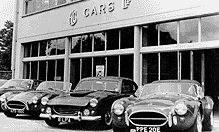AC Cobra Apparel and Accessories by Legend Lines
 AC Cars, originally incorporated as Auto Carriers Ltd., is a British specialist automobile manufacturer and one of the oldest independent car makers founded in Britain. As a result of financial problems over the years, the company was renamed or liquidated many times until its present form. The first car from what eventually became AC was presented in 1903 by The Weller brothers. Forward several years to September 1961, when AC was approached by Carroll Shelby to use a small block Ford V8 engine in the Ace chassis, producing the AC Cobra. Shelby needed a car that could compete with the Chevrolet Corvette in US sports car racing. Only a single example was built (CSX 2000) using a Ford 221 Windsor V8. It debuted in 1962 with a Ford 260 V8 engine. This was then superseded by the Ford 289 V8 engine. The resulting Cobra was a very powerful roadster, and it is commonly blamed for the introduction of the 70 mph (110 km/h) limit on British motorways. While this was a major factor in the decision, after a coupe version was caught doing 196 mph (315 km/h) during a test run, a then-recent spate of accidents under foggy conditions also helped the introduction of the limit. Its European model was branded with the AC brand. At the end of the 1964 racing season, the Cobra was being outclassed in sports car racing by Ferrari. Carroll Shelby decided he needed a bigger engine. A big block Ford FE series 390 V8 was installed in a Cobra but it was over powered and the car was now almost undrivable. It was decided that a completely new chassis was needed. With the combined help of Ford's computers and the experience of the AC engineers, the new MKIII was born with 4-inch (100 mm) main tubes instead of 3-inch (76 mm) ones for the chassis, adding huge cross-braced shock towers and coil springs all around. In 1965 a competition version with a stripped interior, no glove box, different instrument layout and revised suspension was introduced. The competition version also had a more powerful motor with only one carburetor, side exhausts, a roll bar and wider fenders to accommodate racing tires. The engine that was installed in the car was Ford's famed 427 FE NASCAR "Side-Oiler" V8, a power-house engine developing 425 bhp (317 kW) in its mildest street version.
AC Cars, originally incorporated as Auto Carriers Ltd., is a British specialist automobile manufacturer and one of the oldest independent car makers founded in Britain. As a result of financial problems over the years, the company was renamed or liquidated many times until its present form. The first car from what eventually became AC was presented in 1903 by The Weller brothers. Forward several years to September 1961, when AC was approached by Carroll Shelby to use a small block Ford V8 engine in the Ace chassis, producing the AC Cobra. Shelby needed a car that could compete with the Chevrolet Corvette in US sports car racing. Only a single example was built (CSX 2000) using a Ford 221 Windsor V8. It debuted in 1962 with a Ford 260 V8 engine. This was then superseded by the Ford 289 V8 engine. The resulting Cobra was a very powerful roadster, and it is commonly blamed for the introduction of the 70 mph (110 km/h) limit on British motorways. While this was a major factor in the decision, after a coupe version was caught doing 196 mph (315 km/h) during a test run, a then-recent spate of accidents under foggy conditions also helped the introduction of the limit. Its European model was branded with the AC brand. At the end of the 1964 racing season, the Cobra was being outclassed in sports car racing by Ferrari. Carroll Shelby decided he needed a bigger engine. A big block Ford FE series 390 V8 was installed in a Cobra but it was over powered and the car was now almost undrivable. It was decided that a completely new chassis was needed. With the combined help of Ford's computers and the experience of the AC engineers, the new MKIII was born with 4-inch (100 mm) main tubes instead of 3-inch (76 mm) ones for the chassis, adding huge cross-braced shock towers and coil springs all around. In 1965 a competition version with a stripped interior, no glove box, different instrument layout and revised suspension was introduced. The competition version also had a more powerful motor with only one carburetor, side exhausts, a roll bar and wider fenders to accommodate racing tires. The engine that was installed in the car was Ford's famed 427 FE NASCAR "Side-Oiler" V8, a power-house engine developing 425 bhp (317 kW) in its mildest street version.
Select the model's year to refine your search |
|---|
-
Sort by












































